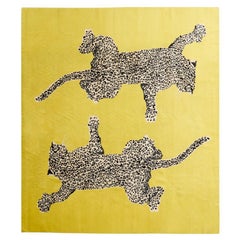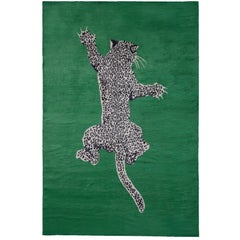Climbing Leopard Rug
Diane Von Furstenberg Double Climbing Leopard Rug 13'W x 13'L
By The Rug Company, Diane von Furstenberg
Located in Rio Vista, CA
Dramatic one-off bespoke custom color double climbing leopard silk rug designed by Diane Von
Category
21st Century and Contemporary Nepalese Modern Central Asian Rugs
Materials
Wool, Silk
Recent Sales
Climbing Leopard Hand-Knotted 10x8 Rug in Silk by Diane von Furstenberg
By Diane von Furstenberg, The Rug Company
Located in London, GB
Animal inspiration is classic DVF and this climbing leopard print is no exception. In a lush
Category
21st Century and Contemporary Nepalese Modern Western European Rugs
Materials
Silk
DEPOSIT 1, Climbing Leopard Hand-Knotted 10x8 Rug in Silk by DVF
By Diane von Furstenberg, The Rug Company
Located in London, GB
statement piece is perfect for a dramatic entryway. Diane von Furstenberg climbing leopard is hand-knotted
Category
21st Century and Contemporary Nepalese Modern Western European Rugs
Materials
Silk
Final Deposit, Climbing Leopard Hand-Knotted 10x8 Rug in Silk by DVF
By Diane von Furstenberg, The Rug Company
Located in London, GB
Final Deposit.
Animal inspiration is classic DVF and this climbing leopard print is no exception
Category
21st Century and Contemporary Nepalese Modern Western European Rugs
Materials
Silk
People Also Browsed
A Fantastic Pair of French leather Club Chairs Chapeau de Gendarme models C1950
Located in Hastings, GB
A Fantastic Pair of French leather Club chairs Circa Chapeau de Gendarme models1950’s
This is a great pair of compact, original French leather club chairs. The lovely, full grain th...
Category
Mid-20th Century French Mid-Century Modern Club Chairs
Materials
Leather
$4,728 / set
H 30.32 in W 31.89 in D 28.35 in
Wrought-iron animal mirror by Atelier Marolles, France, 1950s.
By Jean Touret, Atelier Marolles
Located in SOTTEVILLE-LÈS-ROUEN, FR
French Mirror Attributed to the Ateliers de Marolles, 1950s
Striking mid-century French mirror attributed to the renowned Ateliers de Marolles.
The rectangular frame in patinated ir...
Category
Vintage 1950s French French Provincial Wall Mirrors
Materials
Wrought Iron
David Hockney, A Bigger Book
By David Hockney
Located in Los Angeles, CA
Hardcover, 50 x 70 cm (19.6 x 27.5 in.), 498 pages, 13 fold-outs, with an adjustable bookstand designed by Marc Newson, plus an illustrated 680-page chronology book
A Bigger Book,...
Category
21st Century and Contemporary European Books
Materials
Paper
Dong Son Culture Ritual Bronze Drum, 4th-3rd Century BC, Vietnam
Located in Austin, TX
A well cast and intricately decorated bronze drum from the Dong Son culture, circa 4th - 3rd century BC, Red River Delta, Vietnam.
The face of the drum features a central 8 pointed...
Category
Antique 15th Century and Earlier Vietnamese Antiquities
Materials
Bronze
Beautiful Pair of Late 19th Century Gilt Bronze, Enamel and Sèvres Style Vases
By Manufacture Nationale de Sèvres
Located in Long Island City, NY
A Beautiful Pair of Late 19th Century Gilt Bronze and Champlevé Enamel Mounted White Sèvres Style Vases
Gilt bronze tops above a long neck with raised gold designs. The painted fron...
Category
Antique Late 19th Century French Belle Époque Porcelain
Materials
Enamel, Bronze, Ormolu
$25,000 / set
H 26 in W 12 in D 9 in
19th Century Chinese Canopy Wedding Bed
Located in Marbella, ES
This is a wonderful example of a canopy bed from Shanghai Province, China. Made of Chinese Northern Elm, this bed features hoofed feet and multiple floral carvings.
The exterior ...
Category
Antique 19th Century Chinese Beds and Bed Frames
Materials
Gold Leaf
Italian Gilt Wood Mirror
Located in Montreal, QC
Italian Rococo gilt and carved wood mirror.
Category
Antique 1750s Italian Wall Mirrors
Materials
Giltwood
Collectible Sculptural wood Italian cabinet bar and storage Gianfranco Frattini
By Gianfranco Frattini
Located in Milano, IT
Rare and beautiful wood cabinet attributed to Gianfranco Frattini, Italy, 1950 - 60s.
It is a symbol of elegance and functionality. This extraordinary piece, made of oak, is charact...
Category
Vintage 1950s Italian Mid-Century Modern Cabinets
Materials
Wood
$5,703
H 74.41 in Dm 28.35 in
"Celine" Scalloped Bench in Olive Cotton Velvet by Christiane Lemieux
Located in New York, NY
Introducing the Celine Bench, designed with a uniquely shaped scalloped back and solid oak hand-turned legs that complement its elegant curves. Perfectly sized as an end-of-bed bench...
Category
2010s Cambodian Benches
Materials
Fabric, Oak
$2,513 / item
H 24 in W 56 in D 23.5 in
“Whale” Dining Table, After Carlo Mollino, C. 1949.
By Carlo Mollino
Located in Philadelphia, PA
Crafted of veneered plywood, brass and glass, this wonderful table would be a unique addition to your contemporary / seaside / shore décor. The table features a rectangular glass top...
Category
Mid-20th Century American Dining Room Tables
Materials
Brass
Turtle Sterling Silver Box
By Fratelli Lisi
Located in Milan, IT
Elaborate workmanship imbues this ornate box shaped like a turtle with indelible character. Entirely handcrafted from sterling silver by Florentine artisan silversmith house Fratelli...
Category
2010s Italian Other Sterling Silver
Materials
Sterling Silver
Unusual French Art Deco Figural Fire Screen
Located in Bridgewater, CT
Art Deco figural fire screen in patinated and wrought iron with a motif of volutes and polychrome couple in the central medallion, French, 1930s. Measures: H 32.1 in (81.5 cm), L 29....
Category
Vintage 1930s French Art Deco Fireplaces and Mantels
Materials
Wrought Iron
Incredible English Mahogany Seven-Pedestal Dining Table
Located in New Orleans, LA
Measuring over 30 feet in length, this tremendous and highly versatile English dining table is the greatest. It has the ability to transform to a multitude of sizes to fit any occasi...
Category
Antique 19th Century British Neoclassical Dining Room Tables
Materials
Brass
19th Century Louis Seize Marble Fireplace
Located in Casteren, NL
This fireplace is made in the rare marble 'Breche du Nord" wich has arich brown/grey base color with white and dark red veigns and beautiful fossils.
This authentic and complete fir...
Category
Antique Mid-19th Century French Fireplaces and Mantels
Materials
Marble
Plump Side Table in Deep Olive, Translucent Polyurethane Resin, by Ian Cochran
By Ian Cochran
Located in New York, NY
Plump Side Table by Ian Cochran
This side table is a continuation of the Plump series of sculptural furniture. This transparent table is a contemporary and modern addition to any sp...
Category
2010s American Modern Side Tables
Materials
Resin
$14,600
H 27 in W 27 in D 27 in
Ingo Maurer 24-Karat Blau Pendant Lamp, Contemporary Modern, Germany
By Ingo Maurer
Located in Buffalo, NY
Ingo Maurer 24-karat Blau pendant lamp, contemporary modern, made in Germany, the shades for 24-karat Blau are made individually by hand, the gold leaf on the shades is beaten to a t...
Category
Early 2000s German Modern Chandeliers and Pendants
Materials
Gold Leaf
Get Updated with New Arrivals
Save "Climbing Leopard Rug", and we’ll notify you when there are new listings in this category.
More Ways To Browse
Diane Von Furstenberg Dvf
French Kitchen Scales
French Limoges Fish Plates
French Louis Xvi Demilune Marquetry Commode
French Olive Pots
French Rocking Horse
French S Marti
French Wedding Vase
Fruitwood China Cabinet
Fujian Cabinet
Galvanized Bin
Game Bird Plate
Game Cock
Garden City Pottery
Garden Pergola
Garden Potting Tables
Gargoyle Table
Gay Fad Barware


